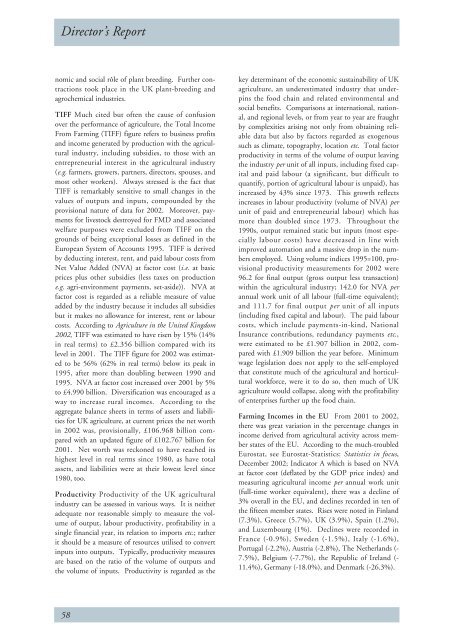PDF file: Annual Report 2002/2003 - Scottish Crop Research Institute
PDF file: Annual Report 2002/2003 - Scottish Crop Research Institute
PDF file: Annual Report 2002/2003 - Scottish Crop Research Institute
Create successful ePaper yourself
Turn your PDF publications into a flip-book with our unique Google optimized e-Paper software.
Director’s <strong>Report</strong><br />
nomic and social rôle of plant breeding. Further contractions<br />
took place in the UK plant-breeding and<br />
agrochemical industries.<br />
TIFF Much cited but often the cause of confusion<br />
over the performance of agriculture, the Total Income<br />
From Farming (TIFF) figure refers to business profits<br />
and income generated by production with the agricultural<br />
industry, including subsidies, to those with an<br />
entrepreneurial interest in the agricultural industry<br />
(e.g. farmers, growers, partners, directors, spouses, and<br />
most other workers). Always stressed is the fact that<br />
TIFF is remarkably sensitive to small changes in the<br />
values of outputs and inputs, compounded by the<br />
provisional nature of data for <strong>2002</strong>. Moreover, payments<br />
for livestock destroyed for FMD and associated<br />
welfare purposes were excluded from TIFF on the<br />
grounds of being exceptional losses as defined in the<br />
European System of Accounts 1995. TIFF is derived<br />
by deducting interest, rent, and paid labour costs from<br />
Net Value Added (NVA) at factor cost (i.e. at basic<br />
prices plus other subsidies (less taxes on production<br />
e.g. agri-environment payments, set-aside)). NVA at<br />
factor cost is regarded as a reliable measure of value<br />
added by the industry because it includes all subsidies<br />
but it makes no allowance for interest, rent or labour<br />
costs. According to Agriculture in the United Kingdom<br />
<strong>2002</strong>, TIFF was estimated to have risen by 15% (14%<br />
in real terms) to £2.356 billion compared with its<br />
level in 2001. The TIFF figure for <strong>2002</strong> was estimated<br />
to be 56% (62% in real terms) below its peak in<br />
1995, after more than doubling between 1990 and<br />
1995. NVA at factor cost increased over 2001 by 5%<br />
to £4.990 billion. Diversification was encouraged as a<br />
way to increase rural incomes. According to the<br />
aggregate balance sheets in terms of assets and liabilities<br />
for UK agriculture, at current prices the net worth<br />
in <strong>2002</strong> was, provisionally, £106.968 billion compared<br />
with an updated figure of £102.767 billion for<br />
2001. Net worth was reckoned to have reached its<br />
highest level in real terms since 1980, as have total<br />
assets, and liabilities were at their lowest level since<br />
1980, too.<br />
Productivity Productivity of the UK agricultural<br />
industry can be assessed in various ways. It is neither<br />
adequate nor reasonable simply to measure the volume<br />
of output, labour productivity, profitability in a<br />
single financial year, its relation to imports etc.; rather<br />
it should be a measure of resources utilised to convert<br />
inputs into outputs. Typically, productivity measures<br />
are based on the ratio of the volume of outputs and<br />
the volume of inputs. Productivity is regarded as the<br />
key determinant of the economic sustainability of UK<br />
agriculture, an underestimated industry that underpins<br />
the food chain and related environmental and<br />
social benefits. Comparisons at international, national,<br />
and regional levels, or from year to year are fraught<br />
by complexities arising not only from obtaining reliable<br />
data but also by factors regarded as exogenous<br />
such as climate, topography, location etc. Total factor<br />
productivity in terms of the volume of output leaving<br />
the industry per unit of all inputs, including fixed capital<br />
and paid labour (a significant, but difficult to<br />
quantify, portion of agricultural labour is unpaid), has<br />
increased by 43% since 1973. This growth reflects<br />
increases in labour productivity (volume of NVA) per<br />
unit of paid and entrepreneurial labour) which has<br />
more than doubled since 1973. Throughout the<br />
1990s, output remained static but inputs (most especially<br />
labour costs) have decreased in line with<br />
improved automation and a massive drop in the numbers<br />
employed. Using volume indices 1995=100, provisional<br />
productivity measurements for <strong>2002</strong> were<br />
96.2 for final output (gross output less transaction)<br />
within the agricultural industry; 142.0 for NVA per<br />
annual work unit of all labour (full-time equivalent);<br />
and 111.7 for final output per unit of all inputs<br />
(including fixed capital and labour). The paid labour<br />
costs, which include payments-in-kind, National<br />
Insurance contributions, redundancy payments etc.,<br />
were estimated to be £1.907 billion in <strong>2002</strong>, compared<br />
with £1.909 billion the year before. Minimum<br />
wage legislation does not apply to the self-employed<br />
that constitute much of the agricultural and horticultural<br />
workforce, were it to do so, then much of UK<br />
agriculture would collapse, along with the profitability<br />
of enterprises further up the food chain.<br />
Farming Incomes in the EU From 2001 to <strong>2002</strong>,<br />
there was great variation in the percentage changes in<br />
income derived from agricultural activity across member<br />
states of the EU. According to the much-troubled<br />
Eurostat, see Eurostat-Statistics: Statistics in focus,<br />
December <strong>2002</strong>; Indicator A which is based on NVA<br />
at factor cost (deflated by the GDP price index) and<br />
measuring agricultural income per annual work unit<br />
(full-time worker equivalent), there was a decline of<br />
3% overall in the EU, and declines recorded in ten of<br />
the fifteen member states. Rises were noted in Finland<br />
(7.3%), Greece (5.7%), UK (3.9%), Spain (1.2%),<br />
and Luxembourg (1%). Declines were recorded in<br />
France (-0.9%), Sweden (-1.5%), Italy (-1.6%),<br />
Portugal (-2.2%), Austria (-2.8%), The Netherlands (-<br />
7.5%), Belgium (-7.7%), the Republic of Ireland (-<br />
11.4%), Germany (-18.0%), and Denmark (-26.3%).<br />
58
















